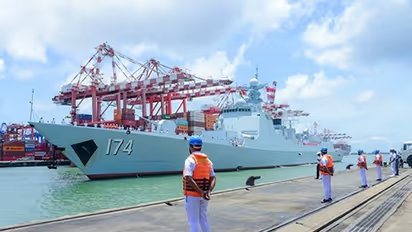Indian Navy's INS Mumbai and 3 Chinese warships dock in Colombo simultaneously amid rising strategic rivalry

Synopsis
Sri Lanka's main port in Colombo played host to a significant maritime event on Monday, as India's frontline warship 'INS Mumbai' and three warships from the Chinese People's Liberation Army Navy (PLAN) made port calls on the same day.
Sri Lanka's main port in Colombo played host to a significant maritime event on Monday, as India's frontline warship 'INS Mumbai' and three warships from the Chinese People's Liberation Army Navy (PLAN) made port calls on the same day. The concurrent visits have piqued interest in the island nation, which has become a focal point in the ongoing strategic contest between the two Asian powers.
The indigenously built destroyer 'INS Mumbai,' which is on its first port call in Sri Lanka, will remain docked for three days. The 163-meter-long destroyer, manned by a 410-member crew, is under the command of Captain Sandeep Kumar.
According to a statement from the Sri Lankan Navy, Captain Kumar met with Rear Admiral Chinthaka Kumarasinghe, Commander of the Western Naval Area. This visit marks the eighth time Indian Navy ships have visited Sri Lanka in 2024, highlighting the deepening naval cooperation between the two nations.
Simultaneously, three Chinese warships—'Hefei,' 'Wuzhishan,' and 'Qilianshan'—arrived in Colombo on Monday morning. The Chinese vessels, part of the PLAN, will participate in a series of programs organized by the Sri Lanka Navy to enhance camaraderie between the two navies. An official statement from the Sri Lankan Navy noted that the commanders of the Chinese vessels are scheduled to meet with Sri Lanka’s Western Naval Commander. Both the Indian and Chinese naval crews are expected to visit several tourist attractions during their stay.
The arrival of both Indian and Chinese warships at the same port on the same day has drawn significant attention, particularly in light of India’s well-known reservations regarding Chinese naval activities in the region. India has repeatedly expressed concerns to the Sri Lankan government over the docking of Chinese research vessels, which it views as a potential security threat.
"Chinese warships, including those part of its anti-piracy escort forces, are now staying in the IOR for a much longer time than earlier," an Indian defence establishment official was quoted as saying in a TOI report.
"The expanding Chinese naval presence in the IOR, along with Beijing's hunt for additional logistical turnaround facilities in the region, has become a major challenge for India," he added.
In response to these concerns, and amid pressure from both New Delhi and Washington D.C., Sri Lanka imposed a ban on the visit of foreign research vessels starting in January 2024. However, in a July 2024 interview with Japanese media, Sri Lankan Foreign Minister Ali Sabry hinted at a possible lifting of this ban in the near future. “We cannot have different rules for different countries and only block China. We will not do that. We will not take sides,” Sabry stated, emphasizing Sri Lanka’s neutral stance in the growing geopolitical rivalry.
The port call by Chinese warships follows a reception hosted by the Chinese Embassy in Colombo last month to mark the 97th anniversary of the founding of the People’s Liberation Army (PLA). Earlier in August, the Sri Lankan Navy also welcomed three U.S. naval warships that were in Colombo for a replenishment visit, underscoring the strategic importance of the island nation in the Indo-Pacific region.
Following its setback in the Maldives, where the Mohamed Muizzu government signed a defense cooperation pact with China and forced the withdrawal of Indian military personnel operating a Dornier aircraft and two advanced light helicopters, India is facing additional challenges. The recent docking of Chinese warships in Colombo has further strained relations, as India has previously protested against Chinese warships, spy vessels, and submarines accessing Sri Lankan ports.
The upcoming Sri Lankan presidential elections on September 21 are now under intense scrutiny. For India, the re-election of President Ranil Wickremesinghe is preferred over Anura Kumara Dissanayake of the National People's Power, who is seen as pro-China.
China's growing influence in the Indian Ocean Region (IOR) is also a concern. With the world's largest Navy, comprising over 360 warships and submarines, China has been enhancing its "underwater domain awareness" in the region through the continuous deployment of survey and research vessels. Additionally, the expanding China-Pakistan maritime collaboration is troubling. China is assisting Pakistan in strengthening its Navy by providing four Type 054A/P multi-role frigates and with eight Yuan-class diesel-electric submarines on the way. By 2028-29, Pakistan is expected to match India's Western Naval Command in terms of naval assets.
Stay updated with the Breaking News Today and Latest News from across India and around the world. Get real-time updates, in-depth analysis, and comprehensive coverage of India News, World News, Indian Defence News, Kerala News, and Karnataka News. From politics to current affairs, follow every major story as it unfolds. Download the Asianet News Official App to stay informed anytime, anywhere.